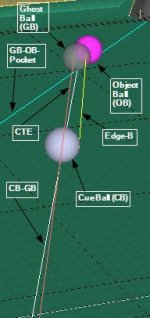jwpretd:
...once the player is correctly positioned by following the prescripts of the methodology, then the CB-to-GB line is offset a short distance (1/2" or so) from the player-perceived CTE line
Isn't it a line between the CTE line and the edge-to-aimpoint line?
Assuming "it" refers to the CB-GB line, then the answer is no, not from the player's perspective at the time the sight lines are acquired. From the player's perspective, for cuts less than 30 degrees the CB-GB line will be outside his CTE sight line, and for cuts greater than 30 degrees, it lies between his CTE sight line and the edge-to-aim point line (i.e., the CB-GB line runs outside of the edge of the OB).
"From the player's perspective" is important. At the time the two sight lines are acquired ("visualized"), he is standing upright, some distance behind the cue ball, offset to one side of the CB-GB and CB-OB center lines, and angled with respect to them (i.e., he is not "directly behind" the cue ball with respect to either the GB or OB, and is above all three). When he visualizes the CTE line, I believe he "sees" it as running from what he perceives as the top center of the cue ball to what he perceives as the geometric center of the cue ball. I believe the other line is visualized as running from the perceived cue ball edge above the table to the OB aim point at the same height. One reason for that belief is that that's how I saw them when I first put a couple of balls on a table and looked at them. Another is that I asked several people who use CTE/ProOne to look at 3D drawings (e.g., post #324 above) and they confirmed that the drawings reflected approximately what they saw when they were positioned properly. There are others - not mysterious, just lengthy and it's late, and I'll post them if you care. All of this conspires to make the relationships between the various lines different from what plane geometry would lead us to expect (again, post #324 above, and c.f.
http://www.thyrsgeat.org/Pool/CTE_ProOne/).
For computational purposes, at least, it's worth noting that none of the perceived ball centers, edge points, or aim points corresponds to the physical points at (x, y, z=2.25) and (x+n, y+m, z=1.125) in the coordinate system of the table; the perceived points are "rotated" "forward" with respect to those points. (Shades of Hal's "rotating edges", eh?

)
I think selection of the unpivoted aimline and selection of the final pivoted aimline ("pivoting") are really one step, whether it's performed as a two-step in CTE or a one-step in Pro One.
I mostly agree about one step, though I'd say that there's really only one aim line - the CB-GB line - and that the intent of CTE/ProOne is to help the player reliably locate that line.
My name for it is "aiming by feel".
I think very nearly all of the "feel", "adjustment", "intuition", "judgement', etc, is absorbed by the act of acquiring the CTE and edge-to-aim-point sight lines. That is, in Lou's terms, it's taken care of by the pre-shot routine

. Once those sight lines are acquired, if the horizontal distance between the perceived CTE sight line and the CB-GB line is calculable, and sufficiently nearly constant over an acceptably short linear distance along the CB-GB line, then in principle there is no "feel" left in the system. Though that would be rather like saying that in principle there's no "feel" involved in the ghost ball system, when, of course, in reality there is.
Whether the system is "exact" depends in part on how you define that. I'm not very happy with any of the definitions I've seen, though Mike Page's had the great virtue of being clear. I think I'd consider the system "exact" in principle if, from the information available to the system, a function existed that for arbitrary cut angles could calculate a bridge point on the CB-GB line that lay within an acceptable bridge length of the cue ball. Is that possible? I don't know, and I spent enough time with mathematical constructivists that I don't like guessing about such things. And that begs the question of whether such "exactness" would have any practical use at the table.

